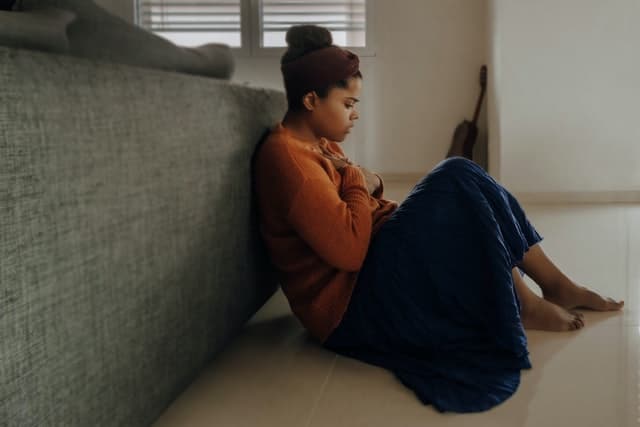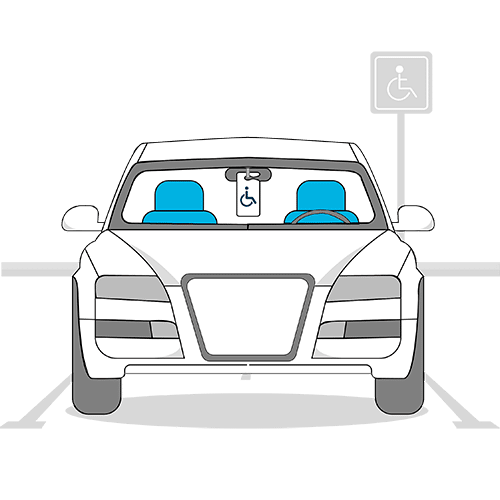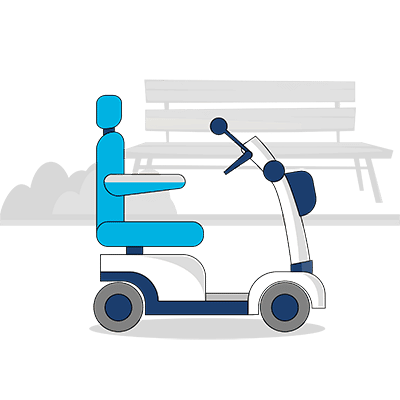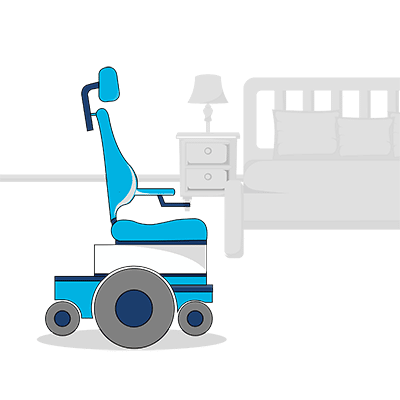Anxiety is one of the most common invisible disabilities in Australia. In fact, half of the 800+ people Blue Badge Insurance surveyed during Invisible Disabilities Week said that they live with anxiety.
Those who’ve never experienced an anxiety disorder often find it difficult to understand the impact it can have on daily life. And for those who live with anxiety, it can be equally hard to explain! The fact that others aren’t always aware you’re living with an invisible disability can make it all the more challenging.
Ever wondered what counts as an anxiety disorder, what it actually means, and how it affects people who live with it? Let’s have a look at anxiety in more depth, from medications and coping mechanisms through to the difference between anxiety and panic attacks.
What is anxiety?
Everyone has been anxious at some point in their lives, both adults and children.
For most people, feelings of anxiety come and go, only lasting a short time with each bout. Some moments of anxiety are briefer than others, lasting anywhere from a few minutes to a few hours before the feelings dissipate.
Sometimes these feelings come and go over a number of days because they’re caused by something in particular. For example, the stress of a work project, nerves about an upcoming event, or concern about an ill family member.
For other people, anxiety lasts much longer. Those who live with an anxiety disorder can experience these feelings continuously over months or years, and it can be so severe that it interferes with their day-to-day life.
Generally, to be diagnosed with an anxiety disorder, the anxiety should:
- Be out of proportion to the situation and/or age-inappropriate (e.g. while a four year old child will often be anxious when meeting a new person, a 40 year old adult wouldn’t usually display the same level of anxiety around it)
- Hinder the ability to function normally
There are several types of anxiety disorders. The most common ones are generalised anxiety disorder, social anxiety disorder, and panic disorder. In addition, there are several specific phobias that fall under the umbrella term of anxiety disorders (such as agoraphobia, for example). You can see a full list of them here.
Who is most likely to develop it?
Anybody can live with anxiety – young, old, male, female, rich or poor.
Statistically speaking a quarter of Australians will experience an anxiety disorder during their lifetime, and women are more likely to be affected than men (one in six women versus one in eight men).
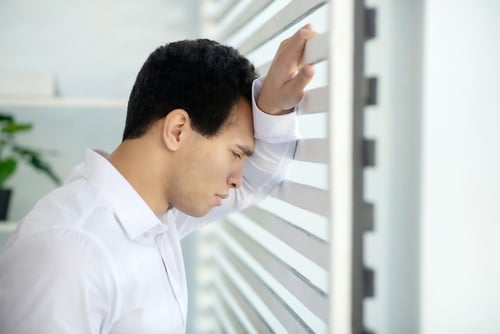
What does anxiety feel like?
What do anxiety disorders actually feel like? Clinical anxiety can feel different from person to person, and it can also feel different from day to day.
People living with anxiety can experience symptoms ranging from a persistent feeling of nervousness or distractedness to a full-blown panic attack complete with physical symptoms.
Symptoms of anxiety can include:
- Racing heart
- Dizziness
- Breathlessness
- Hyperventilating
- Muscle tension
- Racing thoughts
- Sweating and/or trembling
- Feeling restless, tense, or on-edge
- Being easily fatigued
- Sleep problems
As with many disabilities, individual symptoms can vary.
What about panic attacks or anxiety attacks?
What’s the difference between anxiety and panic attacks? And what are they exactly? You might hear people talking about panic attacks and anxiety attacks like they’re the same thing. But although they share some symptoms, they’re not interchangeable terms.
Anxiety attacks aren’t mentioned in the Diagnostic and Statistical Manual of Mental Disorders, which is used to diagnose all mental health conditions. So, they’re not a recognised disorder – but anxiety itself is.
Panic attacks come on suddenly and involve intense and often overwhelming fear. They usually involve very obvious physical symptoms. They can be triggered by something specific, but don’t always have a specific cause.
Panic attacks can happen to anyone, but if you’ve had more than one panic attack it may be a sign of panic disorder.
The symptoms of panic attacks are generally very intense, although quite short-lived. They include:
- Palpitations
- Tightness in chest
- Chest pain
- Hot flashes
- Fear of death or loss of control
- Tingling or numb hands
You’ll notice that many of these symptoms are shared with anxiety. This can make it hard for people to fully understand how and why the two conditions differ.
In short, the main difference between anxiety and a panic attack is the intensity of symptoms and the time for which it lasts. While anxiety is long-lived as a condition, a panic attack usually comes on suddenly and lasts for minutes.

Anti-anxiety medication in Australia
In conjunction with doctors and relevant medical experts (such as a psychologist or psychiatrist) you may decide that medication is the best option to manage your anxiety.
There are a vast number of options when it comes to anxiety medication in Australia. Some are designed specifically to treat anxiety, and others were developed for other uses but can still be beneficial in managing the symptoms of an anxiety disorder.
These include (but are not limited to):
- Beta blockers
- Propranolol
- Sedatives (benzodiazepines like Valium)
- Antidepressants such as SSRI’s and SNRI’s
Your doctors will work with you to find medication which best suits your needs and lifestyle.
Other ways to manage symptoms
Anxiety is a disorder. Much like diabetes or epilepsy can’t be cured by simply thinking positive thoughts, nor can anxiety. However, there are some steps you can take to help lessen the effect it has on your day-to-day life.
In fact, research shows that psychological therapies are a very effective form of treatment for anxiety. There are quite a few different psychotherapy options available, and the right one will depend on your unique circumstances. Your first port of call should always be to work with a reputable mental health practitioner to help you develop coping mechanisms and manage your symptoms as best as possible.
That said, lifestyle changes such as the below can help alleviate symptoms for some people too.
Mindfulness
Practicing mindfulness and focusing on finding inner calm has been said to help plenty of people living with anxiety and depression limit or cope with their symptoms. There are a huge amount of practices you can take part in which fall under “mindfulness”, including yoga, meditation, breathing exercises, visualisation, and a lot more!
Practicing mindfulness diligently can apparently help reduce feelings of anxiousness and stress, make you less emotionally reactive to triggers, help you focus, and help you find calm and peace. Of course, you’ll have to do some experimenting to find out what specific practices work best for you.
Here’s a video on some techniques to get you started on a mindfulness journey – perhaps one or more will be of use to you!
Anxiety rings Australia
We’re seeing a lot of interest in anxiety rings, which aren’t too different to the worry beads Jock Zonfrillo of Masterchef Australia fame is always seen holding.
What do they do? There are lots of designs, but essentially, they’re a discreet accessory people can “fiddle” with by rolling it around your finger, sliding it up and down, rubbing the exterior, or whatever you find comforting and calming. They often make a low hum when they’re spinning or provide a gentle vibration or pressure from the bearings or other spinning element.
The idea is to get you to focus on the ring (rather than on the stress or worry), which can help ground you and help prevent you panicking or overthinking. They’re very similar to fidget spinners, really!
Pets as therapy
Nobody can deny that having a purring cat on your lap or coming home to a dog bounding around is an instant mood-lifter. There are tons of physical benefits of pets, as documented by research.
And there are mental health benefits to pets too. Studies have even shown that stroking pets can reduce anxiety and depression. And it’s no surprise, looking at those cute faces and adorable little paws.
So while we’re not advising you stop the medication or the therapy, maaaaybe you should also add a furry friend to your household?
Living with disability? Get appropriate insurance
If you do have a pet (as emotional support or just because), protecting their health can take one stressor off your mind. Making sure they’re covered if they need quality medical care gives you peace of mind that you’re taking the best care of them possible. And they’re our best friends, so why not? Check out Blue Badge pet insurance to find out how to cover your furkid well.
Aside from pet insurance, people living with disability may benefit from one of our other specialist insurance offerings. Like cover for wheelchairs or insurance for wheelchair accessible vehicles and disability converted cars, for instance.
Plus, if you have a disability parking permit, you qualify for a big discount on both car insurance and pet insurance premiums. Time to get a quote, perhaps?


